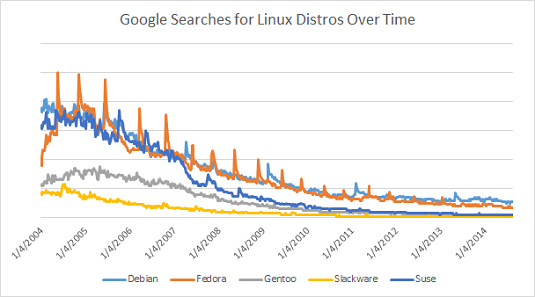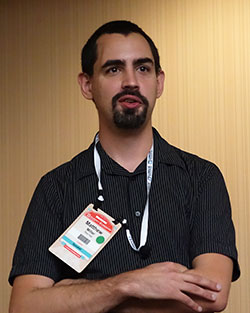Original URL: https://www.theregister.com/2014/08/25/are_linux_distros_boring/
GitHub.io killed the distro star: Why are people so bored with the top Linux makers?
Raise your hand if you're interested – liar!
Posted in OSes, 25th August 2014 18:47 GMT
LinuxCon 2014 Matthew Miller is a little concerned. As the new project leader for the Fedora Linux distribution, he thinks Fedora 20 is great and Fedora 21, when it ships, will be the best release ever. But he worries that to everyone else, Fedora – and Linux distros in general – are getting a little, well … boring.
He doesn't just mean the general public, either. Miller believes much of the broader open source software community has turned its attention elsewhere, too – and at least part of the blame, he says, falls on GitHub.
Speaking at the LinuxCon 2014 conference in Chicago last week, Miller said there are plenty of metrics that show how overall interest in Linux distros has waned since their popularity was at its peak, around 2005–2006.
One example he gave was the conference itself. At one time, Miller said, shows like LinuxCon would have been lined with booths showcasing free Linux distros like Fedora, Gentoo, OpenSuse, and others. This year there were none, and Miller observed that their absence wasn't entirely due to lack of funds.
"Over the last couple of years, those have really been less interesting for the people at the booths," he said. "Our interactions are not that great. It really doesn't seem to build up the community at all."
But Miller's favorite ad hoc metric is Google Trends. Plot the frequencies of Google searches for the names of once-popular Linux distributions over the last decade and you can see the steady decline, to where interest in some distros has practically flatlined. Not even Ubuntu, which exploded in popularity a few years ago, seems immune to the trend.

Judging by Google searches, Linux distros aren't as sought-after as they were (Source: Google Trends)
So what does GitHub have to do with all this? There's no direct correlation, to be sure. But Miller pointed out that while one core audience for Linux has always been open source software developers, open source projects no longer have the symbiotic relationship with Linux distros they once did.
Before the advent of comprehensive Linux distributions, you typically had to download your favorite free software from the creator's own website, or from a file hosting site like SourceForge. Open source software came in many forms and formats, and making it work with your particular OS installation was often a headache.
One huge selling point of Linux distros was that they eliminated this problem. A good Linux distro scoured the world of open source software and assembled the best of it into a cohesive, easy-to-install bundle. Users no longer needed to compile their own packages. After a while, they began to resent it when they had to. As a result, developers very much wanted their software to be included in the more popular distros.
The rise of GitHub has changed this dynamic. Rather than just offering links to tarballs for download, GitHub allows developers to publish their source code in a standard format, accessible by a common set of tools. As a result, Miller observed, GitHub has rapidly become a preferred way for open source developers to offer their software to the public.
Linux distros: gatekeepers no more
"When you go to the Docker website, it doesn't say 'find us in these distros,' it says, 'fork us on GitHub'," Miller said, "and you see that more and more in a lot of prominent open source projects."
And of course, there are far more obscure open source projects than there are prominent ones. When you take these into account, it becomes obvious that the influence of Linux distros – which were once the most prominent curators of open source software – has waned in favor of this new, community-based code sharing model.
"There are something like 15 million repositories on GitHub," Miller said. "And then we have 18,000 packages in Fedora – which is a big number and we're growing very quickly, as well, but there's no way we're going to capture all of that. Even if you follow the general rule where 90 per cent of everything is crap, you can take that out to a lot more 'nines' and you'll still have a number that is way bigger than all of the software that we can possibly package up in the traditional manner."
There are other factors at play, to be sure. The rise of public cloud services means it no longer matters as much which OS the user is running – Linux or otherwise. The app store model that Apple pioneered has yet to really take off in the Linux world, for a variety of reasons, but there are some examples of "stores" that are independent of any one distro, such as language-specific repositories.

Fedora Project leader Matthew Miller
And then there is that Linux buzzword du jour, containers. There were multiple sessions on containers at LinuxCon, and Docker in particular. One way of looking at Docker is that it's an entirely new format for packaging applications, one that obviates the need for distro-specific package formats.
The natural extension of the Docker idea is CoreOS, a Linux distribution in which all applications are delivered as containerized images and the core distro ships with only the bare minimum of software needed to boot and run the system. Compared to Fedora, CoreOS is almost the anti-distro.
Fedora is hardly ignoring these trends. "Fedora.next" is the umbrella term for the ongoing effort to chart the next ten years of Fedora development, and a number of ambitious proposals are on the table.
One idea that will likely come to fruition, Miller said, is to split Fedora into several different "products," including formulations for the desktop, traditional servers, and cloud guests.
Another is to divide the Fedora package library into "rings," where the centermost ring will contain only the most-critical system software and each surrounding ring will contain less-crucial packages. One result of this might be that a bootable Fedora system will consist of fewer than 1,000 packages. It should also make it easier for developers to get their "outer ring" software accepted into Fedora, which Miller admits is too difficult now.
Anyone who cares about the direction that Fedora and Linux in general will take is invited to participate. "There isn't a secret agenda here," Miller said. "I know that, for some reason, people are prone to thinking we have secret agendas. But it is an open process that anybody can contribute to or talk about."
Yet whether these efforts succeed in helping to raise interest in traditional Linux distros, or whether they will inevitably replaced by a more stripped-down system like CoreOS, remains to be seen. From this Reg hack's perspective, however, how the debate pans out over the next few years will be anything but boring. ®